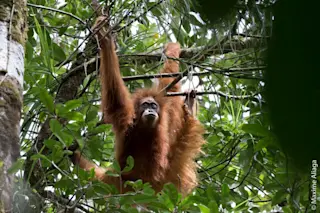We found you Tapanuli orangutan! (Credit: Maxime Aliaga) A newly discovered species of orangutan is already teetering on the edge of extinction. The Tapanuli orangutans (Pongo tapanuliensis) have been identified as the most endangered great ape species in the world, consisting of less than 800 individuals. That population size is strikingly different from the two other known species of orangutans. There are an estimated 14,000 Sumatran orangutans (Pongo abelii) and 100,000 Bornean orangutans (Pongo pygmaeus) currently living in the Indonesian rainforest—both are considered critically endangered. The new orangutan family member is described in a paper published Thursday in Current Biology.
“I think it’s pretty amazing to describe a new great ape species; there’s only seven that have ever been defined, so this is not something that happens all the time,” says Michael Krützen, an anthropologist at the University of Zurich who participated in the study. The research team first suspected ...














